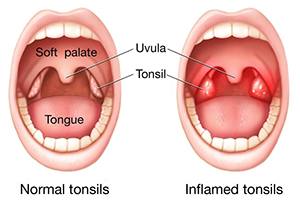-
All about tonsil stones

Your tonsils are oval-shaped pads of tissue in the back of your throat, one on each side. They work as part of your body's immune system to filter bacteria and viruses. Tonsils also make white blood cells and antibodies to help fight infections.
What are tonsil stones?
Tonsil stones form from substances like food particles that become lodged in the crevices of your tonsils. People with large tonsils usually have irregularities on the surface, called crypts. When swallowing, food particles, saliva or mucus can get caught in the holes and become calcified and hard.
Tonsil stones become evident when small pebbles appear on the surface of the tonsils. The stones may look white or yellow. If they form deep in the tissue of the tonsils, the stones may not be visible.
Tonsil redness and irritation are common symptoms of tonsil stones. In some instances, they can cause chronic tonsil inflammation or infection of the tonsils, called tonsillitis.

Tonsil redness and irritation are common symptoms of tonsil stones. In some instances, they can cause chronic tonsil inflammation or infection of the tonsils, called tonsillitis.
People with a history of tonsillitis may be more susceptible. Each time the tonsils are enlarged from infection, small holes tend to develop from the swelling.
People with large tonsils also are more at risk of developing stones. Large tonsils have a large surface area that develops holes on the surface where food particles can collect and turn into tonsil stones.
Prevention
It's difficult to prevent tonsil stones because they are created by food and other substances passing through the mouth to the stomach. While you can't prevent them, you can minimize the development with good oral hygiene.
Brush your teeth after meals, in the morning and before bed. While brushing your teeth, also gently brush your tongue, followed by flossing. Regularly use a mouthwash that does not have an alcohol base. Good oral hygiene reduces the bacteria in your mouth that can lead to the formation of tonsil stones.
Tonsil stones are not harmful to your health and are more of a nuisance than an issue. A frequent complaint about tonsil is that they tend to cause bad breath due to the bacteria that collect on the tonsils.
Treatment
For people with a history of tonsil stones, removing the tonsils is a permanent way to prevent future bouts. The tonsils are removed in a surgery called tonsillectomy.
If tonsillectomy surgery is not an option due to your medical history, age or personal preference, you can manage tonsil stones in other ways.
Talk with your healthcare team about removing them your own. You can remove them by gently pressing on them with a cotton swab. You may also consider using a low-pressure water irrigator to rinse out the crypts in the tonsils. Gargling with salt water after eating can help remove bacteria from the mouth and throat.
You should see an ENT healthcare professional for tonsil stones if your tonsils look red, bleed easily, or experience sore throat or ear pain.
Watch this video to learn more and when you should seek medical attention from an ENT professional:
Pao Vang, M.D., is an otolaryngologist in Eau Claire and Rice Lake, Wisconsin.
This article first published on the Mayo Clinic Health System blog.







